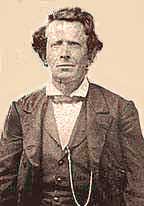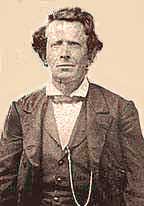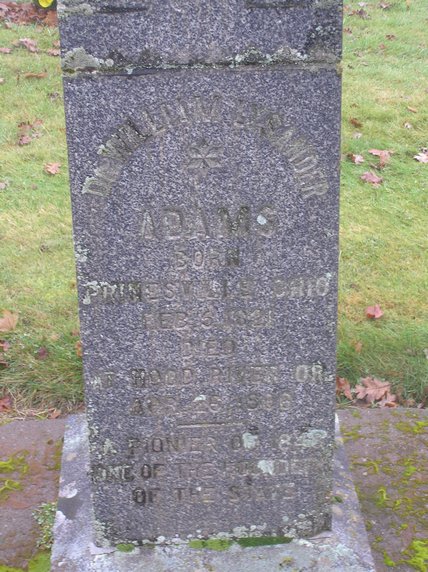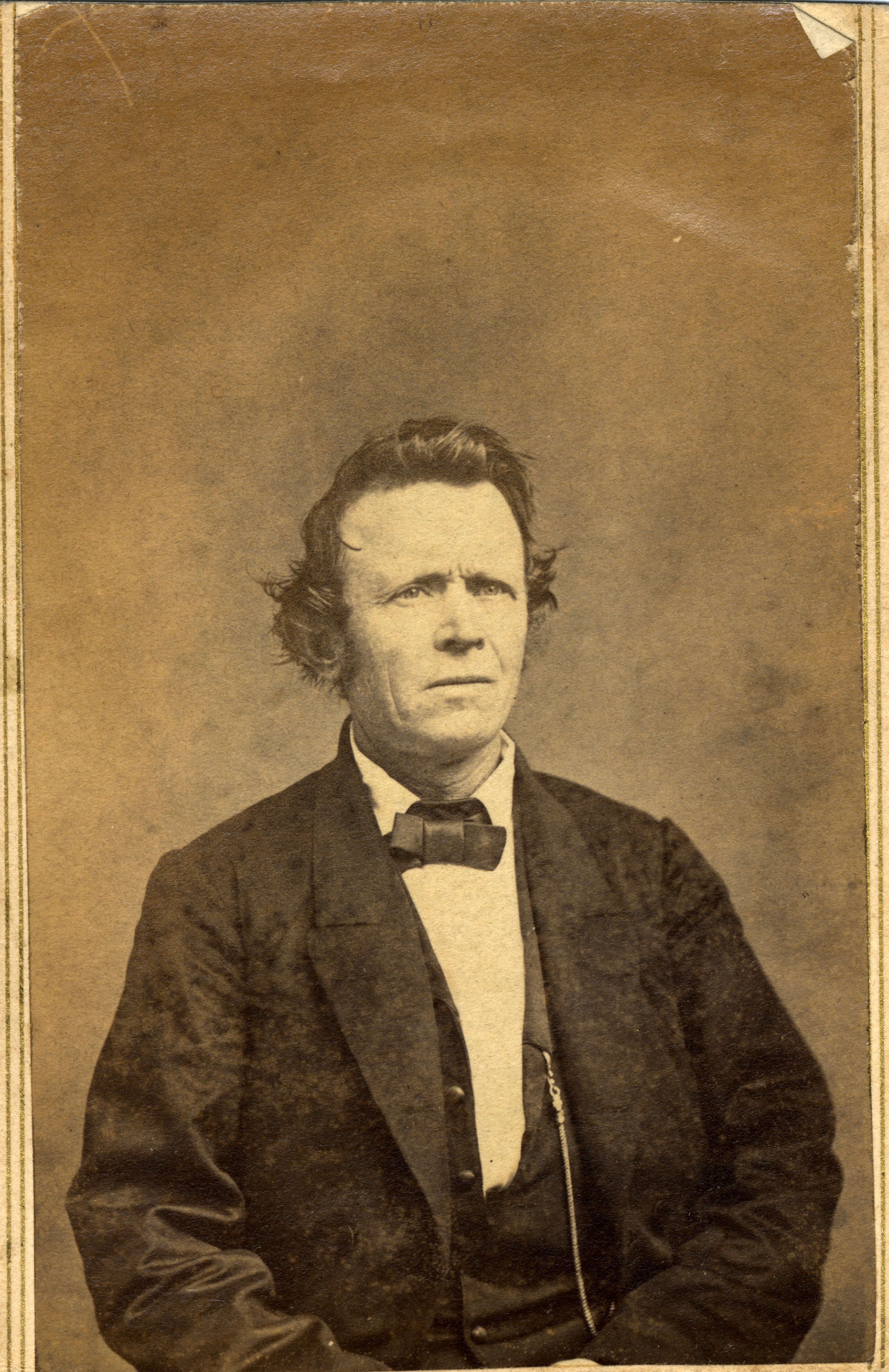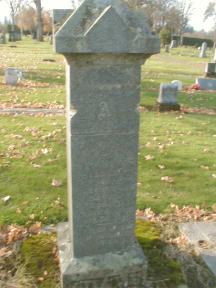Adams was won to the message of being a Christian only. He decided to study at Alexander Campbell's Bethany College in the panhandle of West Virginia. Henry Clay had called Campbell "the greatest man on the American continent." Adams arrived in Bethany with 25 cents in his pocket and was welcomed into Campbell's own home where he boarded while attending school.
While at Bethany, one who knew him said he studied on a average of seventeen hours a day. Adams was soon elected to represent the American Literary Institute in an oration to the vast crowds coming to hear Mr. Campbell on Commencement Day.
W.L. Adams confided to a friend that living with the Campbells, he was "petted and praised more than he deserved." His incessant studies broke down his health and affected his eyesight. He was not able to finish the last month of school, the faculty having advised him to stop to protect his health. He then moved to IL and was sick most of the summer.
In the fall of 1844, he married Frances Olivia Goodell, a school teacher. The next year, he taught school in Henderson County, IL, on the Iowa border.
By 1847 Adams had assembled eight yoke of cattle, two wagons, three guns and other items necessary for the trip west. He delayed one year, selling one of his teams and a wagon to W.W. Bristow, who was leaving in 1847. During this time he declined a five year contract to head a college, preferring to move to Oregon. Even Alexander Campbell wrote to dissuade the talented young Adams from going west. But he persisted.
Tenacious Adams started the trip in March, heading first to St. Joseph, MO, where they joined forty other wagons headed for Oregon. He painted a sign on his wagon: "HIC TRANSIT!" The family consisted of Will, Frances, two-year-old Inez and four-month-old Helen Elizabeth.
On the way, Mr. Adam's library was doused while crossing a swollen river. Mud was sometimes knee-deep. They traveled the Barlow Toll Road past Mt. Hood and arrived at Philip Foster's home at Eagle Creek broke, but undaunted. Mr. Foster gave the hungry family a peck of potatoes and the offer of a teaching job. However, with Yamhill County as the goal, the wagon pushed on to Oregon City, where Mr. Adams borrowed the money for the ferry to cross the Willamette. Upon reaching his destination, he traded his wagon for ten wild Spanish cows. This kept the family in beef for several years.
At the age of twenty-eight, W.L. Adams took a job teaching school just west of present-day Carlton, Or. Mahala McBride agreed to let William and Frances stay in one of their buildings if he would teach their children. His worldview was strongly influenced by that of Alexander Campbell. The McBride's worldview had been shaped by that of Barton W. Stone and John Mulkey with an elevated emphasis on evangelism. An amusing sign over the door of this one-room school read "Yamhill University."
Among the students were eight McBrides, seven Sheltons, two Woods and five or six others, including Levi Lindsay Rowland. One of his students described Adams as "a small, thin, flaxen-haired man. He had no dignity, was slovenly in dress, odd in manner, full of energy, obstinacy, and opinions that were his own." His later photos do not support this description. Perhaps he gave more attention to appearance as he had to deal more and more with the public as a preacher, editor, judge and educator.
Adams had brought his library west. There were about 250 volumes of choice books containing the best literature of the day. When Will Adams headed south to the gold fields in 1849, Francis, an experienced teacher, taught school for one year. Both teacher and some of his students went to pan gold and were successful. There were very few men left in Oregon during the summer of 1849. Adams had another stint at panning gold in 1852 when he went to Yreka, CA, along with eight others. This venture was also successful.
It was Will Adams, more than any other preacher of record, that presented the gospel to the Klickitat Indians that had migrated into Yamhill County. He was their friend and he went to great effort to present the Gospel of our Lord to them at his home. His house was a free resort for the poor, sick, lazy and infirm for more than forty years.
Will Adam's name appears as a special speaker on many occasions, such as the establishing of Pleasant Hill Church near Eugene in 1850. He was one of the speakers on the day the Bethel College building was erected in 1855. He was one of the golden-tongued orators of his time.
William Adams was elected probate judge of Yamhill County and established the Oregon Argus newspaper early in 1855. He edited the Argus for nine years. His critics dubbed it the "Oregon Air Goose." The four page weekly became the mouthpiece of the Republican Party in Oregon as well as the mouthpiece for the Bethel Institute and College. President Abraham Lincoln was a regular reader of the Argus. Politically, Adams was passionately anti-slavery from his Knox College days. During these years he was also a powerful spokesman for the cause of Christ.
Among their several children Helen married John Wesley Johnson. He became the first President of the University of Oregon at Eugene. A writer in the Christian Messenger of 1880 comments that his salary was $2,500 that year. Mr. Johnson is buried in the Masonic Cemetery at E. 25th Avenue and University Street in Eugene.
President Lincoln appointed W.L. Adams as the Collector of Customs at the Port of Astoria in the 1860s. In 1863 he made his home at Forest Grove, practicing self-taught medicine. However, he went to Philadelphia in 1873 and took a course in medicine. He also studied law and received the Doctor of Laws degree from the American University of Pennsylvania. He practiced law and medicine briefly in Portland before moving to Hood River.
At Hood River, where most of the medical part of his life belongs, he engaged in farming and medical practice. He bought a home and said that he was "as happy as a clam thirty feet under water." In 1880 he erected a small building, just outside the town limits of that time, where he sold drugs and notions. He married Mary Sue Mosier in 1881 and they had five children.
In 1888 Adams published a book called "A History of Medicine and Surgery from the Earliest Times". The book was largely a defense of Dr. Adam's methods.
W. L. Adams finished his years at Hood River and is buried in the Idlewild Cemetery.
Amendment added by [email protected]:
Will Adams and his second wife Susan Mosier had two children (Lenore and Percival) not five. He and his first wife Frances had 8 children but one (a twin) died at 4 years of age in 1863 from Scarlet Fever.
Adams was won to the message of being a Christian only. He decided to study at Alexander Campbell's Bethany College in the panhandle of West Virginia. Henry Clay had called Campbell "the greatest man on the American continent." Adams arrived in Bethany with 25 cents in his pocket and was welcomed into Campbell's own home where he boarded while attending school.
While at Bethany, one who knew him said he studied on a average of seventeen hours a day. Adams was soon elected to represent the American Literary Institute in an oration to the vast crowds coming to hear Mr. Campbell on Commencement Day.
W.L. Adams confided to a friend that living with the Campbells, he was "petted and praised more than he deserved." His incessant studies broke down his health and affected his eyesight. He was not able to finish the last month of school, the faculty having advised him to stop to protect his health. He then moved to IL and was sick most of the summer.
In the fall of 1844, he married Frances Olivia Goodell, a school teacher. The next year, he taught school in Henderson County, IL, on the Iowa border.
By 1847 Adams had assembled eight yoke of cattle, two wagons, three guns and other items necessary for the trip west. He delayed one year, selling one of his teams and a wagon to W.W. Bristow, who was leaving in 1847. During this time he declined a five year contract to head a college, preferring to move to Oregon. Even Alexander Campbell wrote to dissuade the talented young Adams from going west. But he persisted.
Tenacious Adams started the trip in March, heading first to St. Joseph, MO, where they joined forty other wagons headed for Oregon. He painted a sign on his wagon: "HIC TRANSIT!" The family consisted of Will, Frances, two-year-old Inez and four-month-old Helen Elizabeth.
On the way, Mr. Adam's library was doused while crossing a swollen river. Mud was sometimes knee-deep. They traveled the Barlow Toll Road past Mt. Hood and arrived at Philip Foster's home at Eagle Creek broke, but undaunted. Mr. Foster gave the hungry family a peck of potatoes and the offer of a teaching job. However, with Yamhill County as the goal, the wagon pushed on to Oregon City, where Mr. Adams borrowed the money for the ferry to cross the Willamette. Upon reaching his destination, he traded his wagon for ten wild Spanish cows. This kept the family in beef for several years.
At the age of twenty-eight, W.L. Adams took a job teaching school just west of present-day Carlton, Or. Mahala McBride agreed to let William and Frances stay in one of their buildings if he would teach their children. His worldview was strongly influenced by that of Alexander Campbell. The McBride's worldview had been shaped by that of Barton W. Stone and John Mulkey with an elevated emphasis on evangelism. An amusing sign over the door of this one-room school read "Yamhill University."
Among the students were eight McBrides, seven Sheltons, two Woods and five or six others, including Levi Lindsay Rowland. One of his students described Adams as "a small, thin, flaxen-haired man. He had no dignity, was slovenly in dress, odd in manner, full of energy, obstinacy, and opinions that were his own." His later photos do not support this description. Perhaps he gave more attention to appearance as he had to deal more and more with the public as a preacher, editor, judge and educator.
Adams had brought his library west. There were about 250 volumes of choice books containing the best literature of the day. When Will Adams headed south to the gold fields in 1849, Francis, an experienced teacher, taught school for one year. Both teacher and some of his students went to pan gold and were successful. There were very few men left in Oregon during the summer of 1849. Adams had another stint at panning gold in 1852 when he went to Yreka, CA, along with eight others. This venture was also successful.
It was Will Adams, more than any other preacher of record, that presented the gospel to the Klickitat Indians that had migrated into Yamhill County. He was their friend and he went to great effort to present the Gospel of our Lord to them at his home. His house was a free resort for the poor, sick, lazy and infirm for more than forty years.
Will Adam's name appears as a special speaker on many occasions, such as the establishing of Pleasant Hill Church near Eugene in 1850. He was one of the speakers on the day the Bethel College building was erected in 1855. He was one of the golden-tongued orators of his time.
William Adams was elected probate judge of Yamhill County and established the Oregon Argus newspaper early in 1855. He edited the Argus for nine years. His critics dubbed it the "Oregon Air Goose." The four page weekly became the mouthpiece of the Republican Party in Oregon as well as the mouthpiece for the Bethel Institute and College. President Abraham Lincoln was a regular reader of the Argus. Politically, Adams was passionately anti-slavery from his Knox College days. During these years he was also a powerful spokesman for the cause of Christ.
Among their several children Helen married John Wesley Johnson. He became the first President of the University of Oregon at Eugene. A writer in the Christian Messenger of 1880 comments that his salary was $2,500 that year. Mr. Johnson is buried in the Masonic Cemetery at E. 25th Avenue and University Street in Eugene.
President Lincoln appointed W.L. Adams as the Collector of Customs at the Port of Astoria in the 1860s. In 1863 he made his home at Forest Grove, practicing self-taught medicine. However, he went to Philadelphia in 1873 and took a course in medicine. He also studied law and received the Doctor of Laws degree from the American University of Pennsylvania. He practiced law and medicine briefly in Portland before moving to Hood River.
At Hood River, where most of the medical part of his life belongs, he engaged in farming and medical practice. He bought a home and said that he was "as happy as a clam thirty feet under water." In 1880 he erected a small building, just outside the town limits of that time, where he sold drugs and notions. He married Mary Sue Mosier in 1881 and they had five children.
In 1888 Adams published a book called "A History of Medicine and Surgery from the Earliest Times". The book was largely a defense of Dr. Adam's methods.
W. L. Adams finished his years at Hood River and is buried in the Idlewild Cemetery.
Amendment added by [email protected]:
Will Adams and his second wife Susan Mosier had two children (Lenore and Percival) not five. He and his first wife Frances had 8 children but one (a twin) died at 4 years of age in 1863 from Scarlet Fever.
Inscription
Pioneer of 1848, One of the founders of the state
Family Members
-
![]()
Inez Eugenia Adams Parker
1845–1933
-
![]()
Helen Elizabeth Adams Johnson
1847–1914
-
![]()
William Harmon Adams
1851–1917
-
![]()
Julia Frances Adams McDaniel
1853–1929
-
![]()
Gaines Melanethon Adams
1856–1922
-
Arthur Craig Adams
1859–1888
-
![]()
Amy Celestia Adams
1859–1946
-
Claribel May Adams Eakin
1862–1928
-
![]()
Percival Lysander "Percy" Adams
1884–1922
-
Lenore Evelyn Adams Mortimer
1891–1947
Sponsored by Ancestry
Advertisement
Records on Ancestry
Advertisement
